
It was the second day of Eidul Fitr. My khala was visiting us with her husband and three kids; two boys (15-year-old and 13-year-old) and a 10-year-old girl. I, on the other hand, was five-years-old at that time. These are the characters that are directly and indirectly related to the ultimate magic trick. I remember all of them and all of us sitting near a gas heater, bonding away like families do over such occasions. My mother, with my three-year-old sister sleeping in her lap, and my khala were discussing family issues, while my father was convincing my khalu to join him in his business and how much more a business can offer these days as compared to a nine to five job. My khala’s daughter was sitting quietly in a corner. Her eldest son was sitting with me while the younger one went to explore the Eid festivities going on outside. As we were all enjoying the chilly evening weather, the doorbell rang and my phupho along with her husband came to pay us the traditional Eid visit. With the crowd increasing, everyone decided to depart towards the living room; the men started off with their ‘men talk’ and the women with their regular chit chat. My mother, after placing my sister in bed, went into the kitchen to fix some tea and snacks. My cousin and I were the only ones left in the room. After a few minutes of awkward silence, he told me that he is a magician and knows how to do some great magic tricks. I, like a charmed child, got excited by the mere sound of the word ‘magic’. He told me that he possesses power over material objects and has the ability to transform soft objects into hard form and vice versa. I was a curious child and the thought of witnessing a magical transformation amazed me. He folded his hand and pointed his index finger towards me, and said that with his great magic power he is going to make his index finger as soft as cotton. I could not contain my excitement. He got up, closed the door and turned off the light. I tried to run away but he grabbed me. I told him to switch the lights back on because I was scared of the dark. He gave me a warm smile and explained that his magic trick will only work in the dark. With the conviction of his words, I agreed to stay, but only if he would hurry up with his magic trick. The room was dark and the only vibrant green light was glowing out of my Teenage Mutant Ninja Turtle watch. I was anxious and wanted him to start the magic trick. He made me lie down on the couch besides him under a blanket and asked me to hold his finger and close my eyes. I simply followed. He then asked me to feel the finger and I did as I was told. I told him that it was still hard and bony. He asked me to keep my eyes tightly shut as the magic trick was about to start. A fear crept up in my heart as quickly as it vanished. I could feel something very soft in my hands. I told him, with a tint of excitement in my voice, that the magic trick was working. He asked me to hold the soft finger tightly and feel it from every angle to make sure that every part of it was soft. I grabbed his soft finger in both hands and felt it from top to bottom and made sure that he is not lying. He really was a magician, I thought, he did actually transform his hard bony finger into a soft boneless finger. Soon after, I got bored and told him I wanted to leave. He stopped me and asked me to wait for the second part of the trick, where he will magically convert his soft finger back to its hard form. By this point, I was bored because I was only allowed to touch the soft finger and not see it. I didn’t want to be there for the second part but because he was being really polite, I decided to stay. I was told to hold his soft finger for four to five minutes and then suddenly, I could feel his soft finger turning hard in my hands. I was lost in wonder and excitement. My young heart could not fathom how he managed to do it. The magic trick really worked, I thought in excitement. I smiled at bhai jan, thanked him for generously showing me his magic trick and for choosing me from amongst all the other kids around to witness the trick.





 Photo: Reuters[/caption]
Which reminds me, people getting together for
Photo: Reuters[/caption]
Which reminds me, people getting together for  Photo: Nzaar Ihsan[/caption]
What are the Pakhtuns up to? After 67 years, will this be that elusive year in which we have only one Eid throughout Pakistan? Do we go take the girls out for choorian and mehendi or do we go for taraveeh? Will masterjee (tailor) or rangwala (dyer), as the case may be, have my suit/dupatta ready on time?
While we respect the concept of 30 rozas and all, one has to admit that nothing beats the exhilaration (and relief) of a chand raat announcement on the evening of the 29th. And they’re probably right when they say that Satan is locked up during Ramazan, because the moment
Photo: Nzaar Ihsan[/caption]
What are the Pakhtuns up to? After 67 years, will this be that elusive year in which we have only one Eid throughout Pakistan? Do we go take the girls out for choorian and mehendi or do we go for taraveeh? Will masterjee (tailor) or rangwala (dyer), as the case may be, have my suit/dupatta ready on time?
While we respect the concept of 30 rozas and all, one has to admit that nothing beats the exhilaration (and relief) of a chand raat announcement on the evening of the 29th. And they’re probably right when they say that Satan is locked up during Ramazan, because the moment  Photo: INP/File[/caption]
Relationships – chachus, khalas and SMSs
With no distractions like bakras or butchers, Choti Eid is all about relationships. Poor people take their children to Minar-e-Pakistan, the rich ones take their families to the golf course, and almost everyone takes their kids to meet their chachus, phupos, khalas and mamoos. The big cities tend to empty out as millions of people travel back to their pind (if you’re from Punjab), mulak (if you are Pathan) or gaon (if you are from anywhere else in Pakistan). There are reports every Eid about the
Photo: INP/File[/caption]
Relationships – chachus, khalas and SMSs
With no distractions like bakras or butchers, Choti Eid is all about relationships. Poor people take their children to Minar-e-Pakistan, the rich ones take their families to the golf course, and almost everyone takes their kids to meet their chachus, phupos, khalas and mamoos. The big cities tend to empty out as millions of people travel back to their pind (if you’re from Punjab), mulak (if you are Pathan) or gaon (if you are from anywhere else in Pakistan). There are reports every Eid about the  Photo: Shahbaz Malik/Express[/caption]
4. The maulvi prays to God for everyone’s health, safety, prosperity and asks for our sins to be wiped clean.
5. He then goes on to ask God to liberate
Photo: Shahbaz Malik/Express[/caption]
4. The maulvi prays to God for everyone’s health, safety, prosperity and asks for our sins to be wiped clean.
5. He then goes on to ask God to liberate  Photo: Reuters[/caption]
9. On the way out, I wish ‘
Photo: Reuters[/caption]
9. On the way out, I wish ‘ Photo: AFP[/caption]
Fresh crisp notes actually become an industry in the week running up to Eid and immediately after namaz, the entire public workforce (the dakia (mailman), the kachra walay (janitor), the bijli walay (electricians) and the likes) starts turning up at the door to collect Eidi.
Photo: AFP[/caption]
Fresh crisp notes actually become an industry in the week running up to Eid and immediately after namaz, the entire public workforce (the dakia (mailman), the kachra walay (janitor), the bijli walay (electricians) and the likes) starts turning up at the door to collect Eidi.

 Photo: Ambreen Malik[/caption]
Ingredients:
Koftas: To be made a day before
Minced beef – ½ kilogram
Chickpea lentil (channa daal) – ½ cup (soaked overnight)
Garlic – 5 to 6 cloves
Ginger – 1 (2 inches)
Onion – 1 medium-sized (chopped)
Green chillies – 2 medium-sized (chopped)
Water – 1½ cup
Salt – 1 tsp
Eggs – 11 (8 hard boiled and 1 for coating)
Oil – 1 cup (for deep frying)
Dry spices:
Whole cloves – 8
Whole black peppercorn – 10
Cinnamon stick – 1
Black cardamom – 2
Cumin seeds – 1 tsp heaped
Coriander seeds – 1 tsp heaped
Whole dried red chillies – 3
[caption id="" align="alignnone" width="595"]
Photo: Ambreen Malik[/caption]
Ingredients:
Koftas: To be made a day before
Minced beef – ½ kilogram
Chickpea lentil (channa daal) – ½ cup (soaked overnight)
Garlic – 5 to 6 cloves
Ginger – 1 (2 inches)
Onion – 1 medium-sized (chopped)
Green chillies – 2 medium-sized (chopped)
Water – 1½ cup
Salt – 1 tsp
Eggs – 11 (8 hard boiled and 1 for coating)
Oil – 1 cup (for deep frying)
Dry spices:
Whole cloves – 8
Whole black peppercorn – 10
Cinnamon stick – 1
Black cardamom – 2
Cumin seeds – 1 tsp heaped
Coriander seeds – 1 tsp heaped
Whole dried red chillies – 3
[caption id="" align="alignnone" width="595"] Photo: Ambreen Malik[/caption]
Curry:
Onions – 3 large (diced)
Tomatoes – 2 medium-sized (diced)
Ginger/garlic paste – 1 tsp
Water – 3½ cups
Yogurt – 1/3 cup
Oil – 6 tbsp
Dry Spices:
Cumin seeds – 1 tsp heaped and crushed
Coriander seeds – 1 tsp heaped and crushed
Whole black peppercorn – 6
Cloves – 5
Black cardamom – 1
Green cardamom pods – 3
Cinnamon stick – 1
[caption id="" align="alignnone" width="595"]
Photo: Ambreen Malik[/caption]
Curry:
Onions – 3 large (diced)
Tomatoes – 2 medium-sized (diced)
Ginger/garlic paste – 1 tsp
Water – 3½ cups
Yogurt – 1/3 cup
Oil – 6 tbsp
Dry Spices:
Cumin seeds – 1 tsp heaped and crushed
Coriander seeds – 1 tsp heaped and crushed
Whole black peppercorn – 6
Cloves – 5
Black cardamom – 1
Green cardamom pods – 3
Cinnamon stick – 1
[caption id="" align="alignnone" width="595"] Photo: Ambreen Malik[/caption]
Method for koftas:
1. Dry roast all the dry spices and grind them in a spice mill.
2. Add minced beef, chickpea lentil, garlic, ginger, onion, one green chilli, grounded spices, salt and water in a pan. Cook it over medium heat for 45 minutes till the water dries up and the lentil is fully cooked. Set aside and let it cool down completely.
[caption id="" align="alignnone" width="594"]
Photo: Ambreen Malik[/caption]
Method for koftas:
1. Dry roast all the dry spices and grind them in a spice mill.
2. Add minced beef, chickpea lentil, garlic, ginger, onion, one green chilli, grounded spices, salt and water in a pan. Cook it over medium heat for 45 minutes till the water dries up and the lentil is fully cooked. Set aside and let it cool down completely.
[caption id="" align="alignnone" width="594"] Photo: Ambreen Malik[/caption]
3. Add the cooked minced meat into a food processor. Add two uncooked eggs and one medium green chilli, and grind everything finely. Store the mixture in a sealed container and leave it in the fridge overnight.
[caption id="" align="alignnone" width="594"]
Photo: Ambreen Malik[/caption]
3. Add the cooked minced meat into a food processor. Add two uncooked eggs and one medium green chilli, and grind everything finely. Store the mixture in a sealed container and leave it in the fridge overnight.
[caption id="" align="alignnone" width="594"] Photo: Ambreen Malik[/caption]
4. Next day, wrap eight hard boiled eggs in the minced meat mixture.
5. Coat the koftas with a lightly beaten egg and deep fry on high heat.
6. Brown the koftas carefully. While frying, do not touch them unless needed as they can crumble and break. Once fried, remove pan and lay them onto some kitchen paper.
[caption id="" align="alignnone" width="594"]
Photo: Ambreen Malik[/caption]
4. Next day, wrap eight hard boiled eggs in the minced meat mixture.
5. Coat the koftas with a lightly beaten egg and deep fry on high heat.
6. Brown the koftas carefully. While frying, do not touch them unless needed as they can crumble and break. Once fried, remove pan and lay them onto some kitchen paper.
[caption id="" align="alignnone" width="594"]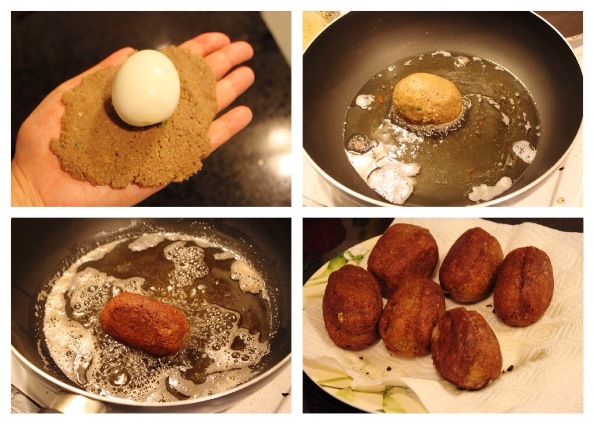 Photo: Ambreen Malik[/caption]
Method for curry:
1. Heat three tablespoons of oil in a pan and fry diced onions till translucent. Add ginger/garlic paste and cook for one minute.
[caption id="" align="alignnone" width="594"]
Photo: Ambreen Malik[/caption]
Method for curry:
1. Heat three tablespoons of oil in a pan and fry diced onions till translucent. Add ginger/garlic paste and cook for one minute.
[caption id="" align="alignnone" width="594"] Photo: Ambreen Malik[/caption]
2. Add diced tomatoes and cook for two minutes on high heat. Add a cup of water and let it come to a boil.
3. Blend the onion and tomatoes mixture into a fine paste in a liquidiser.
[caption id="" align="alignnone" width="594"]
Photo: Ambreen Malik[/caption]
2. Add diced tomatoes and cook for two minutes on high heat. Add a cup of water and let it come to a boil.
3. Blend the onion and tomatoes mixture into a fine paste in a liquidiser.
[caption id="" align="alignnone" width="594"]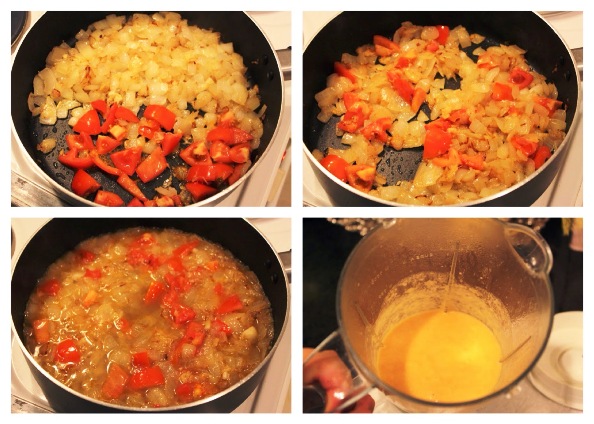 Photo: Ambreen Malik[/caption]
4. Heat the remaining three tablespoons of oil in the same pan and fry the dry spices.
5. Add the liquidised mixture into the pan. Cook until all the water dries up and oil comes out on the sides. Cover the pan as the water starts to vaporise.
[caption id="" align="alignnone" width="594"]
Photo: Ambreen Malik[/caption]
4. Heat the remaining three tablespoons of oil in the same pan and fry the dry spices.
5. Add the liquidised mixture into the pan. Cook until all the water dries up and oil comes out on the sides. Cover the pan as the water starts to vaporise.
[caption id="" align="alignnone" width="594"]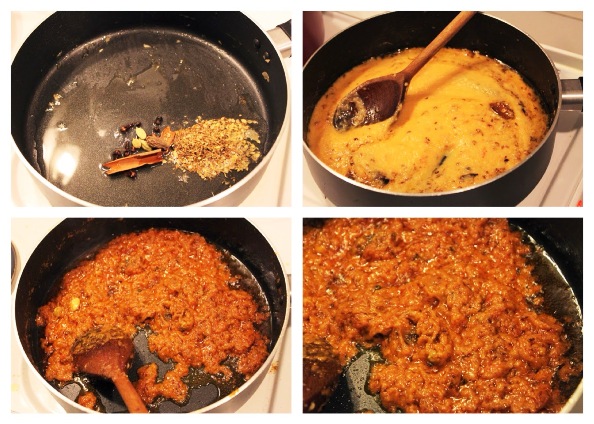 Photo: Ambreen Malik[/caption]
6. Add yogurt and cook till the water from the yogurt dries up.
7. Add two and a half cups of water and let it come to a boil. Lower the heat and let it simmer till oil floats on the top.
[caption id="" align="alignnone" width="594"]
Photo: Ambreen Malik[/caption]
6. Add yogurt and cook till the water from the yogurt dries up.
7. Add two and a half cups of water and let it come to a boil. Lower the heat and let it simmer till oil floats on the top.
[caption id="" align="alignnone" width="594"]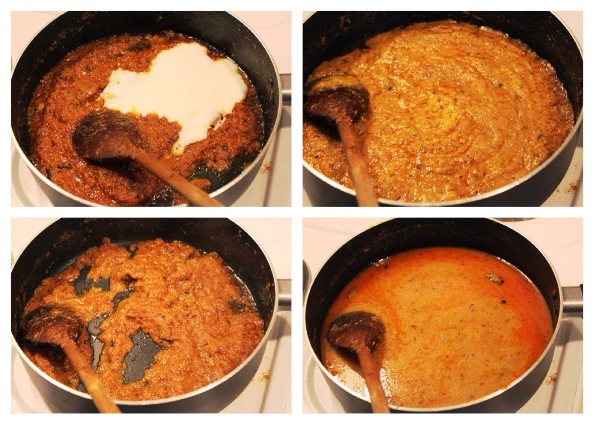 Photo: Ambreen Malik[/caption]
Ladle the hot curry in a serving dish. Cut the fried koftas in half and arrange them in the curry. Garnish with fresh coriander and serve with homemade flat bread – chappati or naan.
[caption id="" align="alignnone" width="590"]
Photo: Ambreen Malik[/caption]
Ladle the hot curry in a serving dish. Cut the fried koftas in half and arrange them in the curry. Garnish with fresh coriander and serve with homemade flat bread – chappati or naan.
[caption id="" align="alignnone" width="590"] Photo: Ambreen Malik[/caption]
Photo: Ambreen Malik[/caption]


 2. Gluttony:
The night before Eid, you believe that you have actually lost weight and will maintain this for the rest of the year. This was what you wanted. You wanted to lose weight and then comes Eid with all its deliciousness and that resolution goes down the drain as soon as we hit the breakfast table. In my opinion, we are known to eat more on the three days of Eid than we do throughout the month of Ramazan because there is So. Much. Food!
[caption id="" align="aligncenter" width="300"]
2. Gluttony:
The night before Eid, you believe that you have actually lost weight and will maintain this for the rest of the year. This was what you wanted. You wanted to lose weight and then comes Eid with all its deliciousness and that resolution goes down the drain as soon as we hit the breakfast table. In my opinion, we are known to eat more on the three days of Eid than we do throughout the month of Ramazan because there is So. Much. Food!
[caption id="" align="aligncenter" width="300"]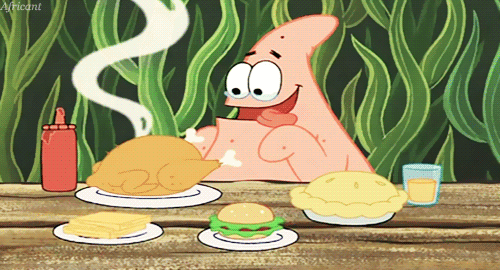 Photo: Tumblr[/caption]
Photo: Tumblr[/caption]
 Photo: Mashable[/caption]
5. Holier than thou much:
All those who scrutinise our every move to find a reason to shame us suddenly drop their Ramazan cloaks and are ready to rumble! Now they are are free to admire Humaima Malick’s new dance.
[caption id="" align="alignnone" width="162"]
Photo: Mashable[/caption]
5. Holier than thou much:
All those who scrutinise our every move to find a reason to shame us suddenly drop their Ramazan cloaks and are ready to rumble! Now they are are free to admire Humaima Malick’s new dance.
[caption id="" align="alignnone" width="162"]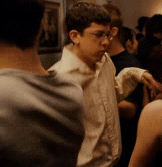 Photo: Funnyjunk.com[/caption]
6. Tailor woes:
Need to get that last minute peeko on your dupatta done or one of your sleeves is somehow shorter than the other? The innumerable curses upon the tailor continue once the roza has ended.
[caption id="" align="aligncenter" width="300"]
Photo: Funnyjunk.com[/caption]
6. Tailor woes:
Need to get that last minute peeko on your dupatta done or one of your sleeves is somehow shorter than the other? The innumerable curses upon the tailor continue once the roza has ended.
[caption id="" align="aligncenter" width="300"] Photo: Tumblr[/caption]
7. Last minute shopping:
Dress? Check.
Shoes? Check.
Jewellery? Check.
Bangles? Oh Crap.
Someone get the car out. Now!
[caption id="" align="aligncenter" width="280"]
Photo: Tumblr[/caption]
7. Last minute shopping:
Dress? Check.
Shoes? Check.
Jewellery? Check.
Bangles? Oh Crap.
Someone get the car out. Now!
[caption id="" align="aligncenter" width="280"] Photo: Tumblr[/caption]
8. Those dreaded hugs:
Eid is one occasion in which 'hugging' suddenly becomes okay. But really, what is the point of the three hugs? Aren't we confused enough already with two or one kisses dilemma that now we need to figure out the amount of times we need to hug? How about a little less action and a little more conversation, please?
Photo: Tumblr[/caption]
8. Those dreaded hugs:
Eid is one occasion in which 'hugging' suddenly becomes okay. But really, what is the point of the three hugs? Aren't we confused enough already with two or one kisses dilemma that now we need to figure out the amount of times we need to hug? How about a little less action and a little more conversation, please?
 Photo: Tumblr[/caption]
9. Eidi-flation:
That moment when you feel like telling your rich relatives about the height of inflation when they hand you that hundred rupee note.
[caption id="" align="alignnone" width="500"]
Photo: Tumblr[/caption]
9. Eidi-flation:
That moment when you feel like telling your rich relatives about the height of inflation when they hand you that hundred rupee note.
[caption id="" align="alignnone" width="500"] Photo: Giphy.com[/caption]
10. Never ending questions:
Unable to strike a conversation? These
Photo: Giphy.com[/caption]
10. Never ending questions:
Unable to strike a conversation? These  Photo: Tumblr[/caption]
11. The table-talkers:
Serving guests who start their discussion with the essence of
Photo: Tumblr[/caption]
11. The table-talkers:
Serving guests who start their discussion with the essence of  Photo: Tumblr[/caption]
Photo: Tumblr[/caption]

 Ingredients for Nurjehani Kheer. Photo: Saira Khan[/caption]
Method:
1. Blend the rice with a little milk to crush roughly.
2. Boil the milk and add rice, khoya, cardamom powder and sugar. Cook this over low heat until slightly thick.
3. Add custard powder, diluted in ¼ cup of milk, stirring rapidly until thick. Let it cool completely.
3. Now add condensed milk and mix well.
4. Dish it out in a serving bowl. Sprinkle chopped almonds and pistachios and dip the cham cham pieces in the kheer. Decorate with it chaandi warq.
[caption id="" align="alignnone" width="540"]
Ingredients for Nurjehani Kheer. Photo: Saira Khan[/caption]
Method:
1. Blend the rice with a little milk to crush roughly.
2. Boil the milk and add rice, khoya, cardamom powder and sugar. Cook this over low heat until slightly thick.
3. Add custard powder, diluted in ¼ cup of milk, stirring rapidly until thick. Let it cool completely.
3. Now add condensed milk and mix well.
4. Dish it out in a serving bowl. Sprinkle chopped almonds and pistachios and dip the cham cham pieces in the kheer. Decorate with it chaandi warq.
[caption id="" align="alignnone" width="540"] Nurjehani Kheer. Photo: Saira Khan[/caption]
Nurjehani Kheer. Photo: Saira Khan[/caption]
 2. Kheer Dilruba
Ingredients: (serves 6-8)
Milk – 1 litre
Rice – 1 cup (boiled and mashed)
Sugar – 3 to 4 tbsp
Vanilla custard powder – 3 to 4 tbsp
Condensed milk – 1 tin
Green cardamom powder – ½ tsp
Pineapple chunks – 1 tin
Bananas – 2 to 3 (finely chopped)
Peach – 1 large (finely chopped)
Almonds and pistachios – ¼cup each (finely chopped)
[caption id="" align="alignnone" width="540"]
2. Kheer Dilruba
Ingredients: (serves 6-8)
Milk – 1 litre
Rice – 1 cup (boiled and mashed)
Sugar – 3 to 4 tbsp
Vanilla custard powder – 3 to 4 tbsp
Condensed milk – 1 tin
Green cardamom powder – ½ tsp
Pineapple chunks – 1 tin
Bananas – 2 to 3 (finely chopped)
Peach – 1 large (finely chopped)
Almonds and pistachios – ¼cup each (finely chopped)
[caption id="" align="alignnone" width="540"] Ingredients for Kheer Dilruba. Photo: Saira Khan[/caption]
Method:
1. Boil the milk for five minutes and add rice and sugar. Boil it for a few more minutes and then thicken it with custard powder (diluted in a little milk).
2. Add almonds and pistachios. Mix it well again and turn off the flame. Let it cool completely.
3. Add all the fruits and condensed milk into it and garnish with pineapple chunks, almond and pistachio. Chill for four to six hours or overnight before serving for best results.
[caption id="" align="alignnone" width="540"]
Ingredients for Kheer Dilruba. Photo: Saira Khan[/caption]
Method:
1. Boil the milk for five minutes and add rice and sugar. Boil it for a few more minutes and then thicken it with custard powder (diluted in a little milk).
2. Add almonds and pistachios. Mix it well again and turn off the flame. Let it cool completely.
3. Add all the fruits and condensed milk into it and garnish with pineapple chunks, almond and pistachio. Chill for four to six hours or overnight before serving for best results.
[caption id="" align="alignnone" width="540"] Kheer Dilruba. Photo: Saira Khan[/caption]
Kheer Dilruba. Photo: Saira Khan[/caption]
 Ingredients for Coconut Kheer. Photo: Saira Khan[/caption]
Method:
1. Cook the tapioca (sabudana) with water until cooked, translucent and thick.
2. Add sugar and coconut milk and mix quickly. Stir it continuously until it becomes thick. Add cream and red food colour. Then mix well, turn off the heat and let it cool down.
3. Now add all the fruits and chill it before serving.
[caption id="" align="alignnone" width="498"]
Ingredients for Coconut Kheer. Photo: Saira Khan[/caption]
Method:
1. Cook the tapioca (sabudana) with water until cooked, translucent and thick.
2. Add sugar and coconut milk and mix quickly. Stir it continuously until it becomes thick. Add cream and red food colour. Then mix well, turn off the heat and let it cool down.
3. Now add all the fruits and chill it before serving.
[caption id="" align="alignnone" width="498"] Coconut Kheer. Photo: Saira Khan[/caption]
So there you have it - three simple Kheers that will keep your guests licking their spoons till the very end!
Eid Mubarak to all you kitchen experts (you might as well be one after all the hard work that goes on in the kitchen!).
Coconut Kheer. Photo: Saira Khan[/caption]
So there you have it - three simple Kheers that will keep your guests licking their spoons till the very end!
Eid Mubarak to all you kitchen experts (you might as well be one after all the hard work that goes on in the kitchen!).

 At the BWA Christmas Bazaar 2014, Beach Luxury Hotel, Karachi. Photo: Mushal Zaman[/caption]
It goes beyond these misconceptions. By recognising various religious festivities, we grant our minorities their
At the BWA Christmas Bazaar 2014, Beach Luxury Hotel, Karachi. Photo: Mushal Zaman[/caption]
It goes beyond these misconceptions. By recognising various religious festivities, we grant our minorities their  At the BWA Christmas Bazaar 2014, Beach Luxury Hotel, Karachi. Photo: Mushal Zaman[/caption]
I would suggest all who read this blog to take part in such activities – it’ll only help you grow stronger as an individual and as a member of society.
At the BWA Christmas Bazaar 2014, Beach Luxury Hotel, Karachi. Photo: Mushal Zaman[/caption]
I would suggest all who read this blog to take part in such activities – it’ll only help you grow stronger as an individual and as a member of society.

 Photo: IMDb[/caption]
This year you will bear witness the rise of a rather different kind of a Marvel Comics superhero – Ant Man.
Directed by Peyton Reed,
Photo: IMDb[/caption]
This year you will bear witness the rise of a rather different kind of a Marvel Comics superhero – Ant Man.
Directed by Peyton Reed,  Photo: IMDb[/caption]
Emma Stone, Joaquin Phoenix, and Jamie Blackley will appear in Woody Allen’s recent production,
Photo: IMDb[/caption]
Emma Stone, Joaquin Phoenix, and Jamie Blackley will appear in Woody Allen’s recent production,  Photo: IMDb[/caption]
Any movie starring
Photo: IMDb[/caption]
Any movie starring  Photo: Bajrangi Bhaijaan Facebook page[/caption]
Each year, Bollywood releases a Salman Khan movie on Eid that smashes box office records. This year, Salman will be playing the role of Pavan Kumar Chaturvedi and Bajrangi Bhaijaan in Bajrangi Bhaijaan. Some reports claim that Salman is
Photo: Bajrangi Bhaijaan Facebook page[/caption]
Each year, Bollywood releases a Salman Khan movie on Eid that smashes box office records. This year, Salman will be playing the role of Pavan Kumar Chaturvedi and Bajrangi Bhaijaan in Bajrangi Bhaijaan. Some reports claim that Salman is 


 Wishing everyone a lovely Eid with your loved ones!
All photos: Shayma Saadat
This post originally appeared
Wishing everyone a lovely Eid with your loved ones!
All photos: Shayma Saadat
This post originally appeared 
 And some days I yearn for kebab-e-dayg, a kebab dish prepared in a large pot, a dayg. A rich tomato sauce is prepared with a fragrant base of caramelised onions and garlic to which kebabs are added and simmered till the sauce has seeped into each tender piece. Mopped up with a light-as-air chapatti or drenched over mounds of basmati rice, it is the taste of winters at home in
And some days I yearn for kebab-e-dayg, a kebab dish prepared in a large pot, a dayg. A rich tomato sauce is prepared with a fragrant base of caramelised onions and garlic to which kebabs are added and simmered till the sauce has seeped into each tender piece. Mopped up with a light-as-air chapatti or drenched over mounds of basmati rice, it is the taste of winters at home in 

 Wishing everyone a lovely Eid with your loved ones.
All photos: Shayma Saadat
This post originally appeared
Wishing everyone a lovely Eid with your loved ones.
All photos: Shayma Saadat
This post originally appeared 


